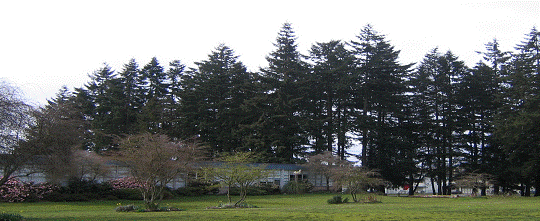“Hate those trees, sure do,” said the Grinch. Reverting back to his old form and stance, the Grinch announced yesterday that he is expanding his franchise of celebrations that we can do away with. Earth Day is one of those.
And in the spirit of those who agree with him, the Grinch awarded an honorary franchise membership to Seattle Public Schools for their dogged efforts to clearcut trees from their school campuses.
Trees are a bad influence on kids said the Grinch. Especially large old trees noted the Grinch. So the Seattle Public School’s efforts to remove 68 large old evergreen trees from the west side of the Ingraham High School campus in North Seattle got the Grinch’s attention.
Brilliant strategy said the Grinch. Seek public money to replace grimy moldy old portables and promise new classrooms to renovate and upgrade the campus. The public supports that. But don’t tell the public paying the bill that the plan is to build the new classrooms smack in the middle of one of the few large groves of old Douglas fir, Western Red Cedar and madrone trees left in Seattle. Most of these trees are now 75 years old and over 100 feet tall.
The Grinch praised Seattle Public Schools for excluding members of the public from participating in the design process. “Neighbors and other members of the public only ask embarrassing questions and waste your time,” said the Grinch.
Part of the strategy to decrease student support for Earth Day celebrations the Grinch noted was the consideration by Seattle Public Schools to also cut down another grove of trees on the east side of the campus by the Helene Madison Pool. In the tree report filed with the City of Seattle dated Oct 22, 2007, the enclosed Ingraham Master Plan had circled this grove of trees and wrote in large letters “POTENTIAL EAST PARKING EXPANSION” – 50 spaces.
“Brilliant!” said the Grinch. “The more we work to encourage students to drive to school by creating more parking spaces, the less environmental habitat there is for them to spend time in marveling and celebrating their natural environment.”
The Grinch said that while the Seattle School District dropped the proposal to cut the east forest down in their current plan, they’ll always be more chances to cut down the trees in the future. “And for now you can tell the public that you’re not going to cut down these trees and look like environmental heroes, while you move forward to decimate the grove on the west side,” he gloated.
The Grinch noted that the trees in the east grove remain a real threat because teachers at Ingraham High School have actually used this area for environmental learning. “Preserving trees and native natural areas are a continuing threat to our efforts to do away with celebrating Earth Day,” said the Grinch.
The Grinch praised the inaction of the Seattle School Board in responding to strong public concern about cutting down the trees. Obviously their continuing to move forward with building the addition as planned is encouraging noted the Grinch. To seriously listen to the taxpayers paying for the school renovation would be a mistake he said. Just stop up your ears he suggested, urging them not to give in to public demands to come up with an alternative design that would save the trees on the west side of the school.
The Grinch urged the Seattle School Board to remove their e-mail contact information from their website at www.seattleschools.org/area/board. “If members of the public get hold of this information, who knows how many might try to contact you, urging you to come up with a new design for the classroom addition that doesn’t require cutting down the 68 large Douglas fir, western red cedar and Pacific madrone trees on the west side of the campus.”
“And for God’s sake don’t tell them about the open grassy lawn on the North side of the school where you could build the new classrooms and not have to cut down any large trees.” yelled the Grinch.
The Grinch was last seen dancing a jig and then running away, yelling at the top of his voice, “Cut down those trees now!” Again and again.




